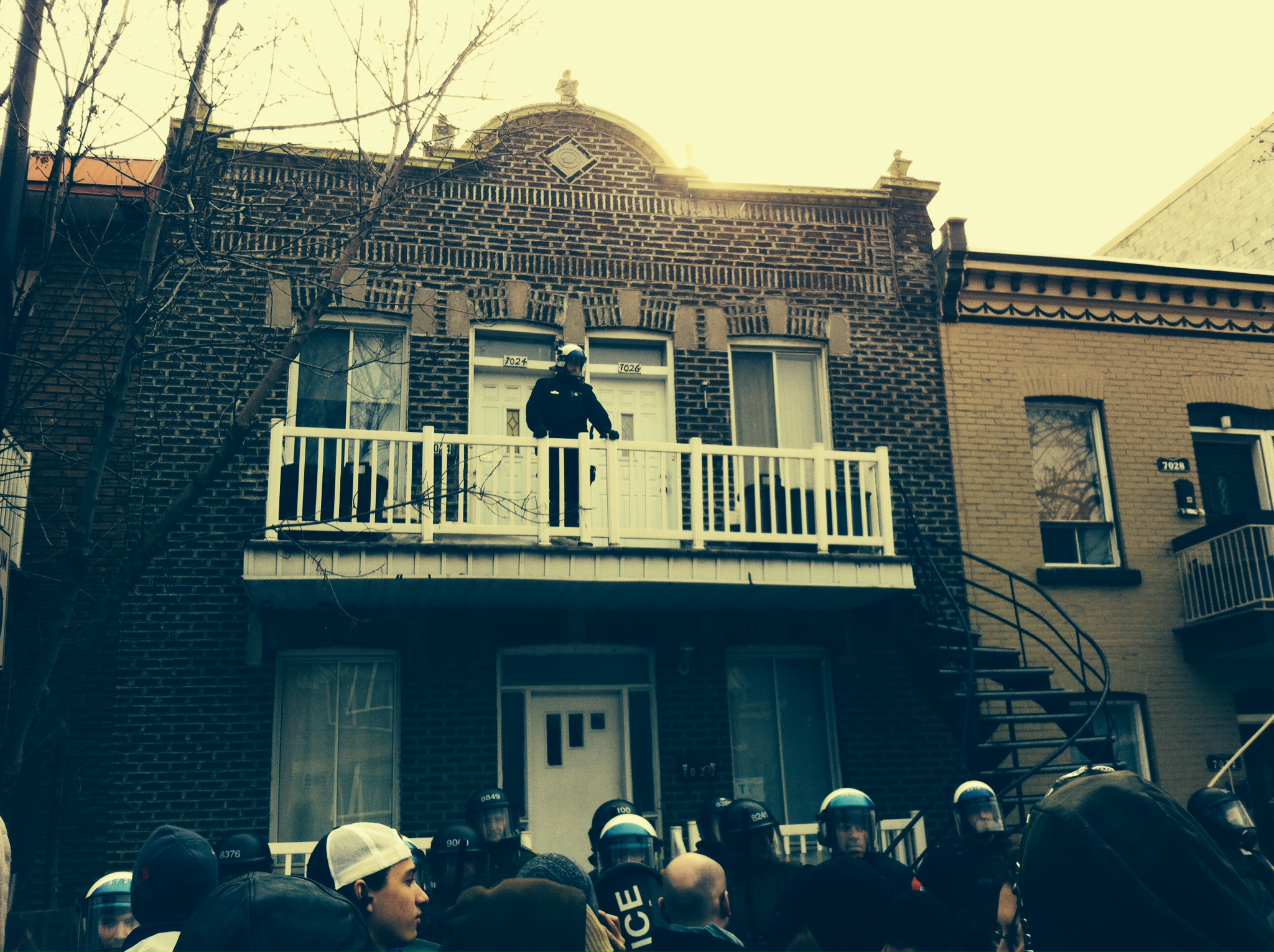Montreal : Reflections from inside a police kettle
Mar 16, 2014
Montreal : Reflections from inside a police kettle

After spending hours in a Montréal police kettle on late winter afternoon, your heartbeat is quick and your mind is racing, full of reflections on the inherent institutional violence of the police.
Taking the streets today for the annual protest against police brutality was an obvious and necessary choice. Over recent months Montréal has seen a growing wave of police killings that target the most vulnerable in society.
Transmitting the tragedy involved in these police killings, for the ones lost, their loved ones and community is impossible to convey with one protest, or in these simple words. Until today there is no justice for all those killed by Montréal police, no serious legal process or public accounting on this horrifying wave of police killings in our city.
As calls for justice, from the family members and communities impacted by these killings, continue to ring out, joining the annual protest against police brutality is urgently important.
Donald Ménard died in the early evening on Nov. 11 last year, shocks from a police taser gun killed the 41-year-old during an intervention at a rooming house in the Centre-Sud. Ménard died in circumstances never fully communicated or justified by police, a pattern that cuts across many cases.
Only last month a community vigil to remember Jean-François Nadreau took place in Montréal's east-end. Killed by a police bullet in February 2011, Jean-François died at home within the context of a mental health crisis in circumstances that clearly presented no serious threat to the police on the scene.
Farshad Mohammadi, a refugee from Iran living on the streets of Montréal, died on a concrete floor at métro Bonaventure in early January 2012. Montréal police shot and killed Mohammadi during an intervention that clearly presented little grave danger to the police involved. Mohammadi who traveled to Canada as a refugee, to seek protection, ended up homeless and marginalized on the streets, a soul struggling to survive in poverty who was not given the support needed, but instead killed by an institution that claims to serve and protect our city.
Fredy Villanueva, a teenager from a working class family with roots in Honduras, was killed by police bullets in August 2008 while playing a game of dice with friends in a Montréal north park. Villanueva’s death sparked nighttime community protests, that many have contrasted with similar community revolts against police violence and impunity common to the immigrant suburbs of Paris.
Incredibly the list of police killings in Montréal is very long and communicating the full picture here in one text, both in regards to specifics or the human tragedy, is impossible. Many grassroots activists working to stop police violence, impunity and killings, point to 89 police killings having taken place since 1987. Beyond this being a shocking statistic, quickly illustrated in human terms in the cases highlighted above, each figure represents a preventable tragedy.
Taking the streets in this context is critically important. Beyond these police killings, the rise of police violence and impunity in the city is real. Also the militarization of the police is real. Last fall the Montréal police introduced a $360,000 armoured vehicle, that looks like an urban tank, described by police as a “mobile barricade can take a pounding from projectiles.”
Throughout the Québec student uprising in 2012, as thousands took the streets to protest the imposition of a violent neo-liberal austerity agenda by the Parti libéral du Québec (one that has been continued under a Parti Québécois government), the violence on the part of the police was extreme.
Police consistently fired dangerous rubber bullets and launched flash bang grenades against popular student and community protests. Flash bangs are built by Defense Technologies, a subsidiary of the world's second largest arms manufacturer, BAE Systems and are rubber-encased devices that explode, creating a 175-decibel shock wave, while emitting a flash of light and releasing a charge of CS gas into the air. CS gas is a chemical irritant that burns the eyes, affects the respiratory system and can cause vomiting.
Striking students were seriously injured, including students who lost eyes and sustained broken bones. In a consistent pattern, seen across violent policing incidents, there has been no justice for all those abused, injured and unjustly arrested during the « Printemps érable ».
Taking the streets today on the international day against police brutality is about justice and accountability, a grassroots response to the incredible and unaccountable violence of the police. Within the context of the P6 municipal bylaw, that undercuts our capacity to freely protest, taking the streets this year is even more critical.
Standing together on Chateaubriand Ave. refusing to ignore systemic police violence and killings in our city, refusing to be silenced by P6, builds our solidarity. Hours in a police kettle, chanting together, enforces bonds, strengthening our collective determination to end police impunity and to create transformative social change.

